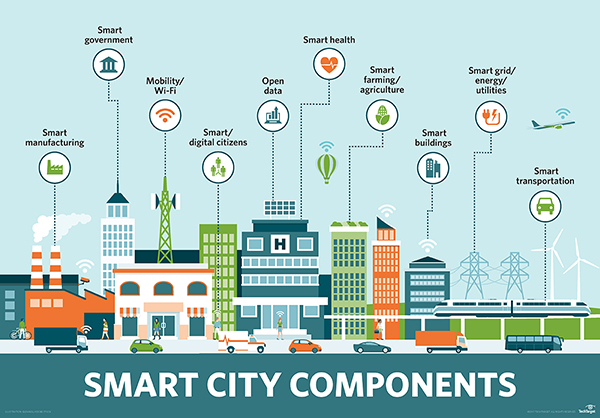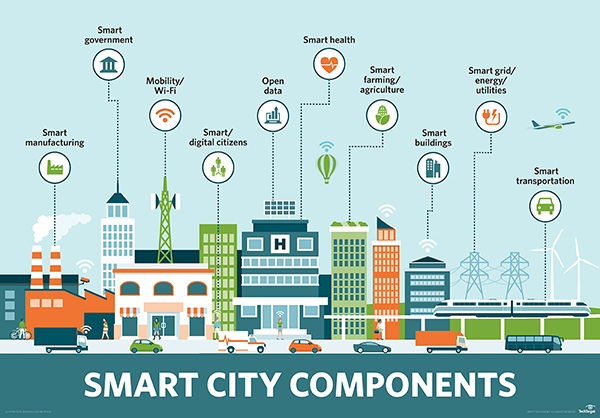IoT in Smart Cities: How IoT is Raising the Standard of City Living
What makes a city “Smart”? Consider this as a utility as simple as a building elevator. Which smartly moves people between floors, so users do not have to wait in line. Unlike the traditional elevators, they take the user to the desired floor directly, without any unnecessary stops in between. It also helps to keep the flow smooth without any unnecessary delays. In essence, a smart city aims to resolve citizens’ everyday civic concerns via smart product innovations and sustainable technological solutions. And improve the comfort, convenience, and security of the citizens in effect. Read more about the use of IoT in smart cities, and some awe-inspiring examples of IoT applications that have revolutionized city living across the world.

A smart city framework mainly comprises ICT systems, IoT applications, and devise sensors, which collect, analyze, and transmit real-time data via wireless technology and cloud-based software.
So, end-users (urban municipalities, citizens, businesses, etc.) can access relevant information via connected mobile devices like smartphones and always make informed data-driven decisions.
The well-connected, IoT-driven smart city ecosystem thus promotes sustainable practices, which are also faster, more efficient, and secure. Besides, such IoT solutions can conveniently alleviate the pain points of the city dwellers. From effective parking space allocation to smart waste disposal, they can substantially improve city living quality with cost-effective, clean technologies.
While a smartly connected community (as illustrated above) may seem like a distant dream, only possible in the tall tales of futuristic, dystopian fictional worlds – a favorable increase in IoT-enabled devices over the last decades has made the “distant dream” more visible today. In fact, such smart, people-focused communities are more real now than ever!
Municipal wastemanagement
Does automated waste collection sound fanciful?
A smart city in South Korea – Songdo is presently actualizing the dream. To streamline the waste collection process, it uses a city-wide network of pneumatic tubes for waste collection and disposal. Thus, eliminating the need for trash bins on street corners or garbage pick-up trucks.
Since every household in the city district is connected, the tubes suck all the garbage underground for disposal while recycling substances that can be recycled.
To take another example of smart waste management: Seoul, South Korea’s capital, also boasts of an intelligent waste collection system with the deployment of Clean Cubes – portable, solar-powered waste bins and compactors embedded with sensors.
These smart bins installed across the city use sensors to monitor fill-level, thus eliminating the need for frequent waste collection or concerns over waste overspill. The bins were also able to reduce the waste collection costs for Seoul by 85%.
Public mobility
To distribute the passenger load evenly across the train cars, train operators in London use real-time data from connected IoT devices to predict how passengers will occupy the train cars for every trip in and out of the city.
The operators typically rely on data collated from movement sensors, ticket sales, and CCTV surveillance deployed on the train platforms. So, at every train station, they encourage passengers to occupy different cars and spread out. As such, they optimally use the capacity of the train and avoid frequent train delays.
Smart parking
The one of the best use of IoT in smart cities, is Smart Parking. The bustling headland of the Sydney Harbor, the suburb of Mosmancity, implemented a comprehensive smart parking system in response to the city’s congestion woes, with two major components – sensors (both overhead and in-ground) and a mobile app called Park Mosman.
How does the system work? The installed sensors collect information in real-time to provide directional information and direct the drivers to available parking spots via the mobile app. This has helped the city council to manage the parking demand around the city’s business centers efficiently.
The smart parking system has also invariably reduced city congestion. The time spent on finding empty parking lots, and improved customer experience favorably.
Connected streetlights
The Chicago Smart Lighting Project initiated in 2017 combated unreliable streetlighting problems to raise the standard of neighborhood life in Chicago, USA.
In a bid to modernize Chicago’s streetlight system, the city council replaced around 85% of the lights with premium quality reliable LED fixtures and a state-of-the-art lighting grid to power them. Streetlights, placed primarily in neighborhoods with security concerns, the new, modern connected streetlights, provided an efficient way to keep the public safety optimal.
The new lights consume nearly 50-75% less electricity, saving energy costs by a lucrative margin to illuminate the streets. What’s more, the city council can remotely monitor the entire outdoor lighting system and offer real-time updates to city dwellers in case of power outages.
In turn, the system promotes swift responses to citizens’ service requests, thereby improving city forces’ efficiency.
Disaster management
In the wake of a local river flood incident, which nearly destroyed the local dams and forced the locals to evacuate La Emilia’s village, situated North of Bueno Aires, Argentina, the local bodies implemented a flood warning system for early detection and prevention.
The system connects various sensors deployed in suitable locations along the river basin with an IoT-enabled cloud that reads and monitors the river water level accurately, in addition to the weather forecast, using real-time data.
In this way, the concerned authorities prevent future risks by meticulously collecting the river surveillance data and long-term statistics to make flood predictions.
The future of smart cities
Seven out of ten people are expected to inhabit a city by 2050. Therefore, as more than 50% of the world population become city-dwellers, automation across city infrastructures will be the most effective way to a smarter, healthier, more efficient, and sustainable living.
Key areas whereapplications of IoT in Smart cities will take a central role include:
- Energy efficiency and environment
- Intelligent buildings
- Transit networks
- Public safety
- Mobility
- Healthcare
- Crime prevention
In any case, a collective effort from across the value chains – city administration, municipal divisions, software providers, urban planners, network service providers, IT infrastructure providers, citizens, etc. will be vital to create a holistic ecosystem for different smart solutions to thrive. And consequently, raise the standards of city living for the better.

